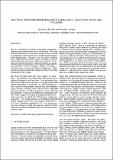Multiple aperture INSAR (MAI) with C-band and L-band data: Noise and precision
Author(s)
Bechor Ben Dov, Noah; Herring, Thomas A.
DownloadBechor_Multiple Aperture.pdf (2.416Mb)
Other Contributors
Massachusetts Institute of Technology. Earth Resources Laboratory
Metadata
Show full item recordAbstract
MAI is a technique to extract along-track (horizontal) phase-based displacements from InSAR data. MAI’s theoretical precision can be at the centimeter level, an order of magnitude improvement over amplitude-based pixel offset approaches. However, MAI has been challenging to implement with most academic InSAR processors, and the theoretical precision difficult to reach for low to medium coherence terrains. We implement MAI with the JPL/CALTECH InSAR processor ROI PAC. We study the MAI noise structure with Envisat, Radarsat-1, ERS, and ALOS data, and develop phase corrections and filtering based on the results.
We study the MAI noise with ’zero’ signal, all noise data. We process 11 Envisat pairs presenting low to medium coherence with less than 2 cm along track displacements, taken over the larger Los Angeles basin/San Gabriel Mountains in California, US. The test data contain a variety of decorrelation sources and cover different types of terrain, including urban, mountainous, vegetated and sea surfaces, as well as variety in temporal and spatial baselines. To test the MAI filter we superimpose the MAI noise images with signal simulating coseismic displacements from the 1812 Mw 7 Wrightwood earthquake sequence. The results present a correlation dependent RMSE ranging from 8 cm in correlation coefficient 0.4 to 2 cm in correlation coefficient 0.75. In an actual signal case (Hawaii, L-band), the random component of the noise for correlation coefficient of 0.5 to 0.95 varies from 2 cm to 4 mm.
Date issued
2012Publisher
Massachusetts Institute of Technology. Earth Resources Laboratory
Series/Report no.
Earth Resources Laboratory Industry Consortia Annual Report;2012-34
Keywords
InSAR